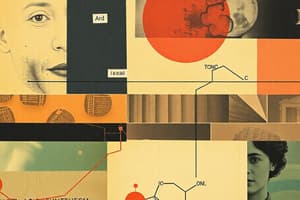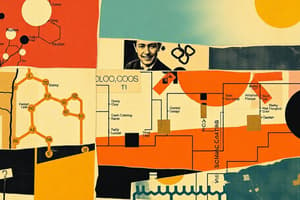Podcast
Questions and Answers
What is the result of the complete hydrolysis of triglycerides?
What is the result of the complete hydrolysis of triglycerides?
- Glycerol and three fatty acids (correct)
- Glycerol and two fatty acids
- Glycerol and five fatty acids
- Glycerol and four fatty acids
How are free fatty acids transported through the cell membrane?
How are free fatty acids transported through the cell membrane?
- By diffusion
- By binding with albumin (correct)
- By active transport
- By binding with hemoglobin
Where does fatty acid degradation occur?
Where does fatty acid degradation occur?
- Golgi apparatus
- Endoplasmic reticulum
- Nucleus
- Mitochondria (correct)
What is the result of the activation of fatty acids?
What is the result of the activation of fatty acids?
Where does fatty acid synthesis occur?
Where does fatty acid synthesis occur?
How is excess acetyl CoA utilized when the liver's oxidative capacity is exceeded?
How is excess acetyl CoA utilized when the liver's oxidative capacity is exceeded?
What is the fate of glycerol produced from triglyceride hydrolysis?
What is the fate of glycerol produced from triglyceride hydrolysis?
What is the energy yield for each cleavage of a saturated carbon-carbon bond in fatty acid degradation?
What is the energy yield for each cleavage of a saturated carbon-carbon bond in fatty acid degradation?
What is the role of hormone sensitive lipase in triglyceride metabolism?
What is the role of hormone sensitive lipase in triglyceride metabolism?
What is the fate of fatty acids with an odd number of carbon atoms in β-oxidation?
What is the fate of fatty acids with an odd number of carbon atoms in β-oxidation?
What is the product of the complete oxidation of fatty acids?
What is the product of the complete oxidation of fatty acids?
What is the key component of the fatty acid synthase complex that allows for the elongation of fatty acid chains?
What is the key component of the fatty acid synthase complex that allows for the elongation of fatty acid chains?
What is the primary carrier for transporting free fatty acids in the blood?
What is the primary carrier for transporting free fatty acids in the blood?
What regulates the transcriptional control of fatty acid synthesis through the phosphorylation of Acetyl CoA carboxylase?
What regulates the transcriptional control of fatty acid synthesis through the phosphorylation of Acetyl CoA carboxylase?
Which molecule is required for the net reaction of palmitate synthesis?
Which molecule is required for the net reaction of palmitate synthesis?
Which process involves the conversion of palmitate to stearic acid and further to monounsaturated fatty acids?
Which process involves the conversion of palmitate to stearic acid and further to monounsaturated fatty acids?
What is the major control point in cholesterol metabolism?
What is the major control point in cholesterol metabolism?
What is primarily involved in cholesterol catabolism?
What is primarily involved in cholesterol catabolism?
What are the major metabolites of cholesterol?
What are the major metabolites of cholesterol?
How is bile metabolism regulated?
How is bile metabolism regulated?
What serves as a precursor for the synthesis of steroid hormones and vitamin D?
What serves as a precursor for the synthesis of steroid hormones and vitamin D?
What are the key components of the fatty acid synthase complex?
What are the key components of the fatty acid synthase complex?
What is the net reaction for palmitate synthesis?
What is the net reaction for palmitate synthesis?
What is the limitation of human cells in synthesizing certain highly unsaturated fatty acids?
What is the limitation of human cells in synthesizing certain highly unsaturated fatty acids?
What are the precursors for the biosynthesis of triacylglycerol (TAG) and phospholipids (PL)?
What are the precursors for the biosynthesis of triacylglycerol (TAG) and phospholipids (PL)?
Which hormone triggers the mobilization and degradation of TAG in adipocytes?
Which hormone triggers the mobilization and degradation of TAG in adipocytes?
What happens to fatty acids and glycerol when TAG is degraded for energy?
What happens to fatty acids and glycerol when TAG is degraded for energy?
What is the fate of most cells' continuously degraded membrane phospholipids (PL)?
What is the fate of most cells' continuously degraded membrane phospholipids (PL)?
What are the precursors for the biosynthesis of triacylglycerol (TAG) and phospholipids (PL)?
What are the precursors for the biosynthesis of triacylglycerol (TAG) and phospholipids (PL)?
What triggers the mobilization and degradation of triacylglycerol (TAG) in adipocytes?
What triggers the mobilization and degradation of triacylglycerol (TAG) in adipocytes?
What happens to fatty acids after the degradation of TAG?
What happens to fatty acids after the degradation of TAG?
What is the fate of glycerol after the degradation of TAG?
What is the fate of glycerol after the degradation of TAG?
Which molecule inhibits the pyruvate dehydrogenase complex?
Which molecule inhibits the pyruvate dehydrogenase complex?
What is the function of dihydrolipoyl dehydrogenase in the pyruvate dehydrogenase complex?
What is the function of dihydrolipoyl dehydrogenase in the pyruvate dehydrogenase complex?
What activates the pyruvate dehydrogenase complex?
What activates the pyruvate dehydrogenase complex?
What is the result of phosphorylation of E1 in the pyruvate dehydrogenase complex?
What is the result of phosphorylation of E1 in the pyruvate dehydrogenase complex?
Which pathway is important for producing NADPH and Ribose-5-PO4?
Which pathway is important for producing NADPH and Ribose-5-PO4?
Where does the Electron Transport System (ETS) primarily take place?
Where does the Electron Transport System (ETS) primarily take place?
Which of the following is an ATP synthesis inhibitor in the Electron Transport Chain?
Which of the following is an ATP synthesis inhibitor in the Electron Transport Chain?
What is the purpose of the Hexose Mono Phosphate (HMP) Pathway?
What is the purpose of the Hexose Mono Phosphate (HMP) Pathway?
Which situation requires the cell to adjust its biochemical pathways to produce only NADPH?
Which situation requires the cell to adjust its biochemical pathways to produce only NADPH?
Which molecule is reduced to produce NADPH in the Pentose Phosphate Pathway?
Which molecule is reduced to produce NADPH in the Pentose Phosphate Pathway?
Which complex in the Electron Transport System is responsible for ATP synthesis?
Which complex in the Electron Transport System is responsible for ATP synthesis?
What is the primary purpose of the HMP-shunt?
What is the primary purpose of the HMP-shunt?
Which compound is used as an uncoupler of electron transport and ATP synthesis?
Which compound is used as an uncoupler of electron transport and ATP synthesis?
What is the end product of the non-oxidative part of the pentose phosphate pathway?
What is the end product of the non-oxidative part of the pentose phosphate pathway?
Which organ is particularly important for the Hexose Mono Phosphate (HMP) Pathway?
Which organ is particularly important for the Hexose Mono Phosphate (HMP) Pathway?
Which molecule is used in the reduction of hydrogen peroxide in cells?
Which molecule is used in the reduction of hydrogen peroxide in cells?
Flashcards
Fatty Acid Synthesis
Fatty Acid Synthesis
A process involving carboxylation of Acetyl CoA to Malonyl CoA.
Fatty Acid Synthesis Regulation
Fatty Acid Synthesis Regulation
Regulated by reversible phosphorylation and allosteric activation by citrate.
Key Components
Key Components
Acyl carrier protein and condensing enzyme; these elongate fatty acid chains.
Palmitate Synthesis Ingredients
Palmitate Synthesis Ingredients
Signup and view all the flashcards
Transcriptional Control
Transcriptional Control
Signup and view all the flashcards
Unsaturated Fatty Acids Synthesis
Unsaturated Fatty Acids Synthesis
Signup and view all the flashcards
Cholesterol Metabolism
Cholesterol Metabolism
Signup and view all the flashcards
Cholesterol Biosynthesis Steps
Cholesterol Biosynthesis Steps
Signup and view all the flashcards
Cholesterol Catabolism
Cholesterol Catabolism
Signup and view all the flashcards
Major Metabolites
Major Metabolites
Signup and view all the flashcards
Bile Acids/Salts Role
Bile Acids/Salts Role
Signup and view all the flashcards
Bile Metabolism
Bile Metabolism
Signup and view all the flashcards
Cholesterol's Role
Cholesterol's Role
Signup and view all the flashcards
Pathways Importance
Pathways Importance
Signup and view all the flashcards
Study Notes
Biochemical Pathways: Fatty Acid Synthesis, Cholesterol Metabolism, and Regulation
- Fatty acid synthesis involves carboxylation of Acetyl CoA to Malonyl CoA, with regulation by reversible phosphorylation and allosteric activation by citrate.
- The key components of the fatty acid synthase complex are the acyl carrier protein and condensing enzyme, which allow for the elongation of fatty acid chains through a series of enzyme steps.
- The net reaction for palmitate synthesis involves the formation of Malonyl CoA and requires multiple acetyl-CoA, CO2, ATP, and NADPH molecules.
- Transcriptional control of fatty acid synthesis occurs through the phosphorylation of Acetyl CoA carboxylase, which is regulated by insulin, glucagon, and AMPK.
- The synthesis of unsaturated fatty acids involves the conversion of palmitate to stearic acid and further to monounsaturated fatty acids, as well as the limitations of human cells in synthesizing certain highly unsaturated fatty acids.
- Cholesterol metabolism includes the biosynthesis of cholesterol in various tissues, with the major control point at the reduction of HMG-CoA to mevalonic acid by HMG-CoA reductase.
- The remaining steps in cholesterol biosynthesis involve the formation of activated isoprene units, condensation to form squalene, and cyclization into the steroid nucleus.
- Cholesterol catabolism primarily involves the elimination of intact steroid nucleus in the form of bile acids and bile salts, which are excreted in feces.
- Major metabolites of cholesterol include bile acids/salts, steroid hormones, and vitamin D, with bile acids aiding in the digestion of lipids.
- Bile metabolism occurs through enterohepatic circulation, where the majority of bile secreted is absorbed and taken back to the liver, regulated by the rate-limiting enzyme 7-α-hydroxylase.
- Synthesis of steroid hormones and vitamin D from cholesterol are essential processes in the body, with cholesterol serving as a precursor for these important molecules.
- The biochemical pathways of fatty acid synthesis and cholesterol metabolism are highly regulated processes involving multiple enzymes, substrates, and regulatory factors, essential for the production of lipids and sterols in the body.
Studying That Suits You
Use AI to generate personalized quizzes and flashcards to suit your learning preferences.



